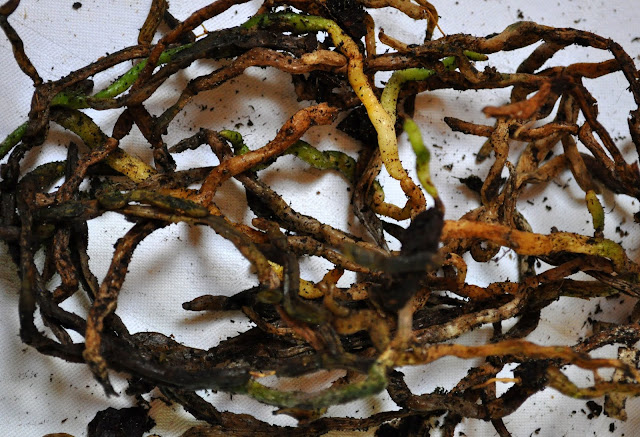Lots of times happens, that people tell me they don’t want to have a Phalaneopsis orchid, because they are afraid that their plants will die on them, becouse it’s to hard to take care of them, and they don’t know how to handle the plants and keep them alive.
Well if they are capable surviving me, they will survive you.
This post will be mostly about transplanting Phalaenopsis, but I’ll write about how to easily take care of them, so they will bring joy and happiness in your lives.
I’m a pretty lousy gardener, when it comes to houseplants. To start with, I’m all excited, and then I usualy forget about them. And so it was with my orchids. For now I only have Phalenopsises, nothing special, just some mixes from garden centers.
This week I transplanted them, and let me show you how It’s done:
Phalaenopsis orchids need to be transplanted in a bigger or in the same pot, when they grow over it. That means, as you can see on the picture, that the plant will grow multiple roots above the pot and soil, or yet better to say bark.
This is how it usualy looks like, when you put it out of the pot. You can clearly see where the old roots end and the new ones begin.
If you watter the Phalaenopsis to much, it could happen that the roots will get roten. Or, if you watter them to little, they will go and dry out. On this picture you can see some overwattered roots, which didn't have a lot of light.
Then you cut off all the bad and the old roots and the flower stems. Of course, you won't transplant a blooming orchid, because it will lose it’s flowers by the shock, which will be caused by the transplantation. But if it is urgent to transplant your orchid, just cut the flower stem off, even if it's in bloom. With that , the plant won't waste it’s energy on it's flowers, and will put everything into the root growth.
While you are handling the Phalenopsis orchid, it might happen that you will break some roots, while putting it in a pot, but don’t worry, if you break them like it shows on the picture, it will be ok - it will be healed and the root will grow further.
But be extra careful not to break the end of the root apex, because the root will stop growing. And when it’s colored light green, it means it grows.
Now you can plant them back in the pot. As I said earlier, you can put them in the same pot thay were in before, because you cut off the roots that are in no use, just be sure, that you clean up the pot first.
For poting you don’t need to buy expencive specialised orchid substrate. You can easily use pine bark, and if you are a lousy watering man, you can add some peet moss. In my case, I used 10% of peet moss, 30% larger fraction of pine bark and 60% of small fraction of pine bark. These orchids are epifits, which means they grow on trees and don’t need soil to grow.
First you put some bark in the pot, and then put the orchid in. Face all the roots down, then add more bark. Meanwhile you will need to shake the pot and orchid a bit so that the bark comes between the roots. The best choice to use are the transparent pots, because the roots also make photosithesys.
Sometimes it can happen, that an old plant will produce a new plant called Keiki. If they have enough roots, you can easily separate them, and plant them each in it’s own pot.
Then, when you are finished, just put them in the tub and shower them. That is one way to watter them. You just have to make sure, that the watter will strain out of the pot. Then watter them just once a week. You can shower them, or you soke the pots in the wather for 15 minutes and then put them out to strain the watter out of the pots, before you put them back on a window shelf. An even better thing to do is, that you watter them only when their roots are grayish green. If the roots are green it means that plant is wattered enough.
And it’s recommended to spray them with watter over their leaves every day.
The most common question I’m asked a lot of times is, why my orchid doesn't want to bloom, and just produces leaves. Well, all you have to do, is to put them in a colder room for a while. It will be enough if the temperature is lower for 5°C, but it shouldn’t go under the 16°C. It will bloom in no time.
O and of course, give them morning sun and some shade in hot summers.
So, read you next time!
Uroš












4 comments:
Kul, bom šerala naprej sestrični ki je nora na orhideje :) (se mi zdi da je lih tako dobila zej za rojstni dan ^^,)
odlično kr dej!
Hi Uros, what I miss on your blog is an About. Would love to know where you are, and what language I am looking at in the comments. Slovenia?
hi. it's coming. soon. and it is slovenian :-D
Post a Comment